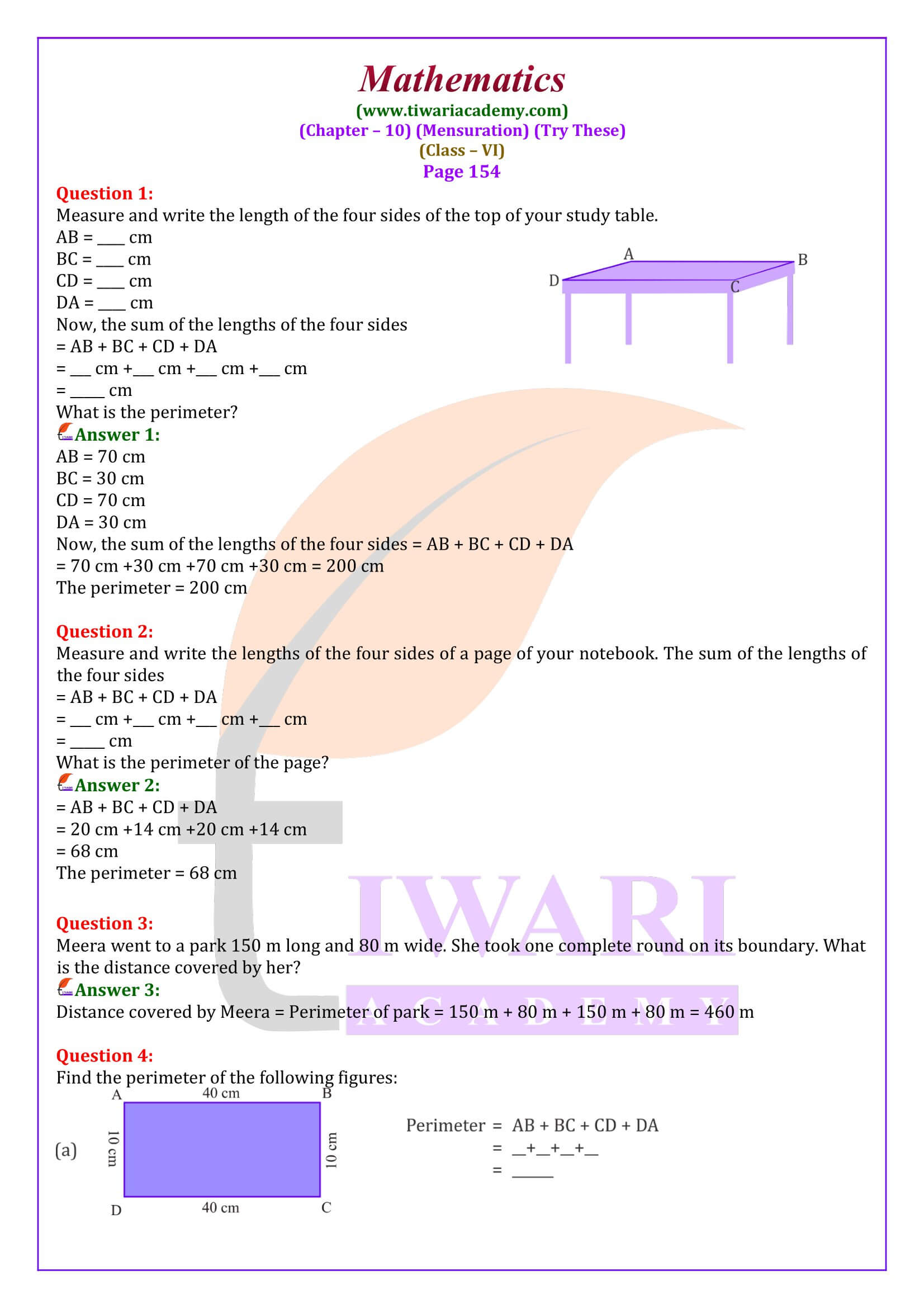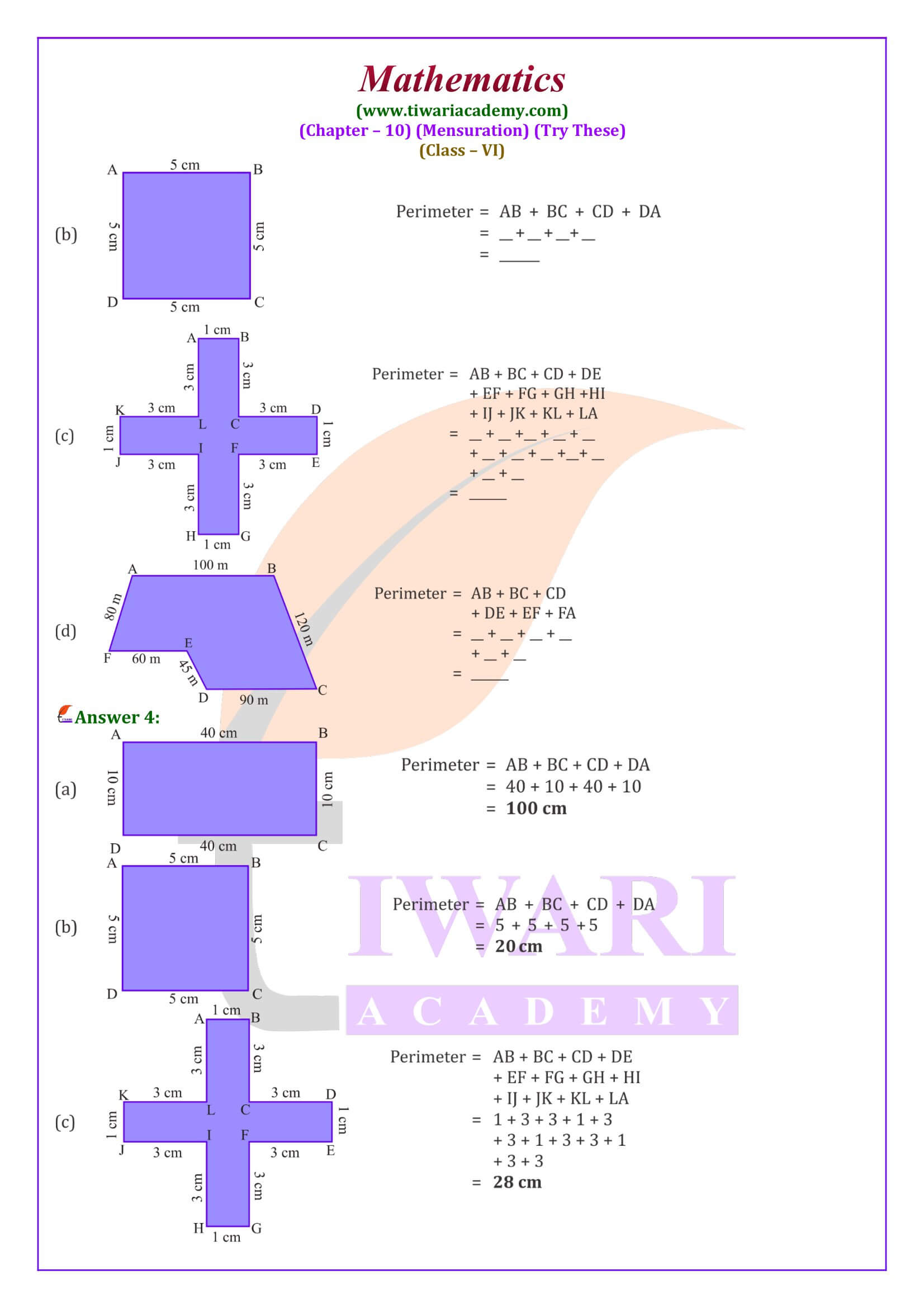NCERT Solutions for Class 6 Maths Chapter 10 Mensuration with Tests and Class 6 Maths Chapter 10 Try These Solutions in Hindi and English Medium updated for new academic session 2025-26. According to revised syllabus of class 6th Maths, there are only three exercises in chapter 10 mathematics given NCERT book for CBSE 2025-26.
Class 6 Maths Chapter 10 Solutions for CBSE and State Boards
Class 6 Maths Chapter 10 Solutions in Hindi Medium
Class 6 Maths Chapter 10 Practice Test
6th Maths Chapter 10 Test 1
6th Maths Chapter 10 Test 2
6th Maths Chapter 10 Test 3
6th Maths Chapter 10 Test 4
6th Maths Chapter 10 Test 5
6th Maths Chapter 10 Test 6
| Class: 6 | Mathematics |
| Chapter 10: | Mensuration |
| Number of Exercises: | 3 (Three) |
| Content Type: | Text and Videos Solution |
| Academic Session: | CBSE 2025-26 |
| Medium: | Hindi and English Medium |

NCERT Solutions for Class 6 Maths Chapter 10
Class VI Maths Exercise 10.1, Exercise 10.2 and Exercise 10.3 in English Medium as well as Hindi Medium updated for new academic session based on new NCERT Books. Solutions of Prashnavali 10.1, Prashnavali 10.2 and Prashnavali 10.3 in Hindi Medium PDF file format to free download. Download textbooks form NCERT (https://ncert.nic.in/) website and Offline NCERT Solutions Apps 2025-26 are also available to free download. Solutions of each question with suitable answers and explanation are given on the website. Download NCERT Solution Offline Apps for Class 6 all subjects.
Download Class 6 Maths Chapter 10 Solutions in PDF Format
Download NCERT Solutions for Class 6 Maths Chapter 10 Mensuration in PDF format updated for new session using the latest NCERT Books 2025-26. For any difficulty, please notify us for help. We are here to help you free of cost.

About Class 6 Maths Chapter 10
In 6 Maths Chapter 10 Mensuration, we will study about the perimeter and area related to various 2-D figures. This chapter is important as per further classes also. We should learn the formulae of perimeter and areas of various figures. Some the the formulae are given below:
Perimeter of a rectangle = 2 × (length + breadth)
Perimeter of a square = 4 × length of its side
Perimeter of an equilateral triangle = 3 × length of a side
Perimeter is the distance covered along the boundary forming a closed figure when you go round the figure once.
Area of a rectangle = length × breadth
Area of a square = side × side
To calculate the area of a figure using a squared paper, the following conventions are adopted:
Ignore portions of the area that are less than half a square.
If more than half a square is in a region. Count it as one square.
If exactly half the square is counted, take its area as 1/2 sq units.
Important Questions on Class 6 Maths Chapter 10
The lid of a rectangular box of sides 40 cm by 10 cm is sealed all round with tape. What is the length of the tape required?
Total length of tape required
= Perimeter of rectangle
= 2 (length + breadth)
= 2 (40 + 10)
= 2 x 50
= 100 cm
= 1 m
Thus, the total length of tape required is 100 cm or 1 m.
A table-top measures 2 m 25 cm by 1 m 50 cm. What is the perimeter of the table-top?
Length of table top = 2 m 25 cm = 2.25 m
Breadth of table top = 1 m 50 cm = 1.50 m
Perimeter of table top
= 2 x (length + breadth)
= 2 x (2.25 + 1.50)
= 2 x 3.75
= 7.50 m
Thus, the perimeter of table top is 7.5 m.
Find the perimeter of a triangle with sides measuring 10 cm, 14 cm and 15 cm.
Perimeter of triangle = Sum of all three sides
= 10 cm + 14 cm + 15 cm = 39 cm
Thus, the perimeter of triangle is 39 cm.
Find the perimeter of a regular hexagon with each side measuring 8 cm.
Perimeter of Hexagon = 6 x length of one side = 6 x 8 m = 48 m
Thus, the perimeter of hexagon is 48 m.
Find the cost of fencing a square park of side 250 m at the rate of ₹20 per meter.
Side of square = 250 m
Perimeter of square = 4 x side = 4 x 250 = 1000 m
Since, cost of fencing of per meter = ₹ 20
Therefore, the cost of fencing of 1000 meters = 20 x 1000 = ₹20,000
A table-top measures 2 m by 1 m 50 cm. What is its area in square meters?
Length of table = 2 m
Breadth of table = 1 m 50 cm = 1.50 m
Area of table = length x breadth = 2 m x 1.50 m = 3 m²
Five square flower beds each of sides 1 m are dug on a piece of land 5 m long and 4 m wide. What is the area of the remaining part of the land?
Side of square bed = 1 m
Area of square bed = side x side = 1 m x 1 m = 1 m²
Area of 5 square beds = 1 x 5 = 5 m²
Now, Length of land = 5 m
Breadth of land = 4 m
Area of land = length x breadth = 5 m x 4 m = 20 m²
Area of remaining part
= Area of land – Area of 5 flower beds = 20 m² – 5 m² = 15 m²
Feedback & Suggestions
We welcomes to your feedback and suggestions. Whenever you face difficulty using website or getting contents, please contact us. We will help you at our level best.
What is the main objective of chapter 10 of Class 6 Maths?
The main objectives of chapter 10 of grade 6th Maths are to clear the following things to the students:
- Perimeter
- The perimeter of a rectangle
- Perimeter of square
- Perimeter of triangle
- The perimeter of pentagon and hexagon
- Area
- Finding area by counting squares
- Area of a rectangle
- Area of a square
- Area by splitting into rectangles
- Finding area by changing units
- Area questions with both square and rectangle.
How many sums are there in Class 6 Maths chapter 10 NCERT Textbook?
In chapter 10 of grade 6th Maths, there are only 3 exercises.
The first exercise (Ex 10.1) has 17 questions. In the second exercise (Ex 10.2), there is only 1 question having 14 parts. The third exercise (Ex 10.3) contains 12 questions. So, there are 30 questions in chapter 10 of grade 6th Maths.
Does chapter 10 of grade 6th Maths contain any good example for terminal tests?
Yes, chapter 10 of grade 6th Maths contains examples. There are 17 examples in chapter 10 of grade 6th Maths. All examples are nice, logical, and interesting. All examples are based on perimeter and area. Students must practice these examples for the exams.
Is chapter 10 of Class 6 Maths interesting or not?
Yes, chapter 10 of grade 6th Maths is very interesting chapter. Students attract to this chapter because this chapter has many real-life applications. The literal meaning of Mensuration is “to measure”. This chapter is very easy if students learn all formulas mentioned in this chapter on tips. Also, this chapter is very important from an exam point of view. Students enjoy doing this chapter.






